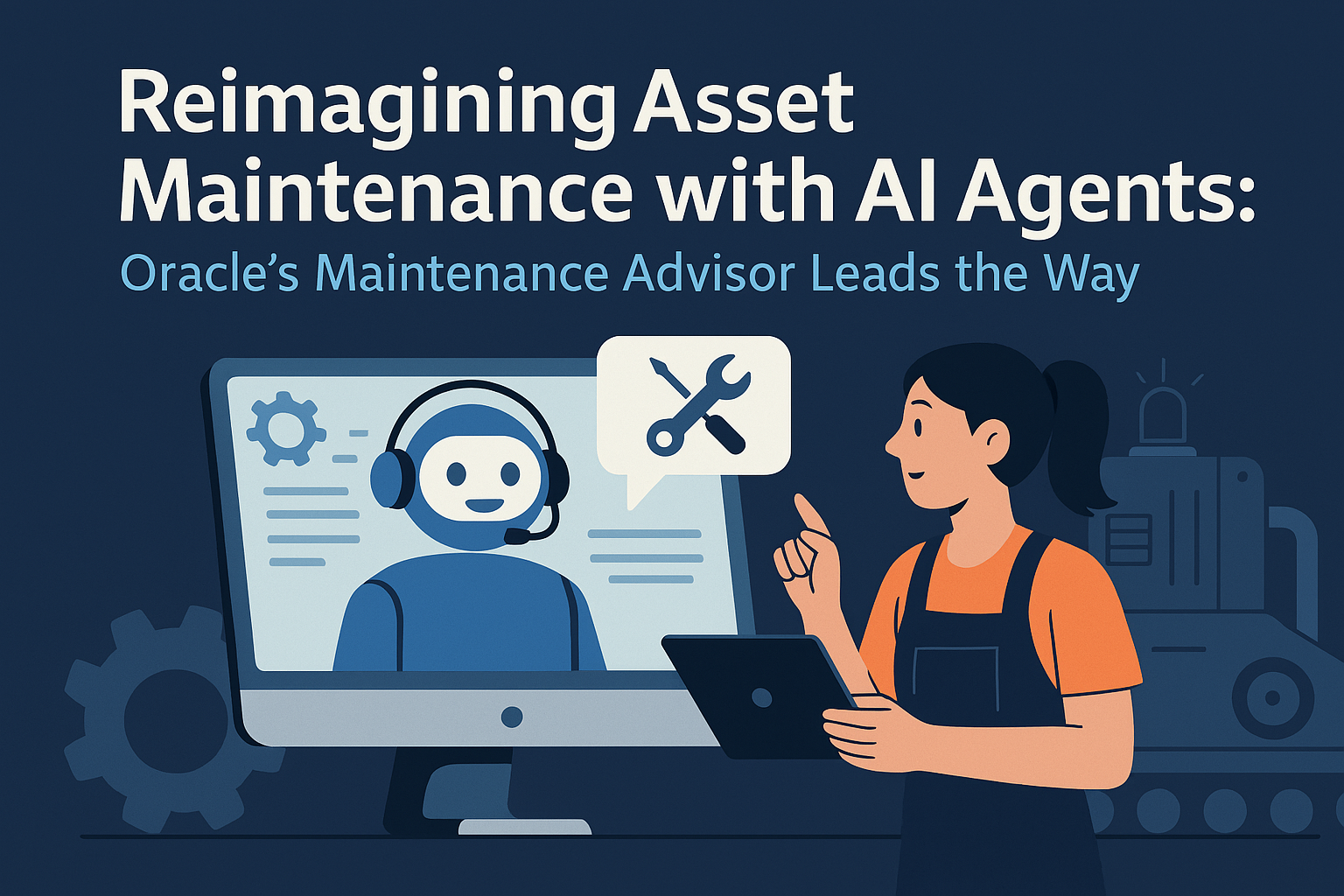Reimagining Asset Maintenance with AI Agents: Oracle’s Maintenance Advisor Leads the Way

In a world of increasingly connected machines, reactive maintenance is no longer enough. The future belongs to intelligent, AI-powered operations — and Oracle's latest release is a step firmly in that direction. Enter the Maintenance Advisor, an AI agent embedded within Oracle Fusion Cloud SCM’s Smart Operations suite — designed to empower technicians with instant, context-rich guidance to resolve equipment issues faster and more effectively.
This is more than a UI enhancement or workflow tool. It represents a shift in how enterprises approach maintenance — from fragmented, document-heavy troubleshooting to intelligent, human-AI collaboration in real time.
Maintenance work is often bogged down by complexity: technicians must sift through thousands of pages of documentation, from equipment manuals to service logs, before taking corrective action. The sheer volume of information means that even the most experienced technician might miss critical context, delaying resolution and increasing asset downtime.
With Maintenance Advisor, this dynamic changes.
When faced with an unfamiliar alarm code or issue, a technician can now converse directly with an AI agent that understands the organization's internal documentation, work order history, and relevant maintenance protocols. Within seconds, the AI parses through vast knowledge bases — including operator instructions, repair histories, technical manuals, and even previously completed service logs — to provide actionable guidance.
This transition from static reference materials to interactive, intelligent assistance marks a significant upgrade for industries reliant on uptime.
Consider this use case: A technician on the shop floor opens the Maintenance Workbench and spots a work order showing an unfamiliar error code flashing on a critical piece of equipment.
Instead of escalating the issue or poring through manuals, she types a simple query to the Maintenance Advisor:
"What does alarm code 8794 mean, and how do I fix it?"
Within seconds, the agent responds:
Identifies the component (a hydraulic actuator)
Connects the code to an issue logged during a similar failure last year
Points to a repair guide from the equipment vendor
Flags a critical note: “Replace gasket only if oil viscosity exceeds threshold.”
Armed with this insight, the technician not only solves the problem faster but also avoids unnecessary part replacements, reducing both time and cost.
For industries like industrial manufacturing, transportation, logistics, healthcare, telecom, high-tech, and F&B, where equipment downtime translates directly to lost revenue, the implications are massive.
Maintenance Advisor improves:
Asset Utilization: Faster diagnosis = more uptime.
Machine Reliability: Historical knowledge = better fixes.
Technician Productivity: Less time searching, more time doing.
Knowledge Retention: AI preserves and shares expertise from past incidents.
And crucially, it reduces reliance on tribal knowledge — capturing learnings across technicians, shifts, and sites into a unified, intelligent knowledge fabric.
This is just the beginning.
The Maintenance Advisor hints at a broader trend in enterprise operations — one where AI agents play a central role in decision support, real-time diagnostics, and even autonomous repair planning.
Imagine what's next:
AI agents detecting anomalies before they trigger alarms
Integration with IoT sensors to recommend predictive interventions
Virtual twin simulations to test maintenance plans before field execution
Autonomous work order generation and parts ordering based on forecasted failures
To implement such intelligent AI agents across complex enterprise environments, organizations need more than just tools — they need cross-functional execution capability.
That’s where Virtual Delivery Centers (VDCs) come in.
A VDC is a plug-and-play model that enables enterprises to rapidly build and deploy AI-driven applications like Maintenance Advisor — by bringing together the right AI engineers, domain experts, and integration teams on-demand. It removes the friction of hiring, orchestrating, and managing siloed teams, and replaces it with an agile, cloud-based delivery center that works as an extension of the enterprise.
VDCs can:
Rapidly prototype and train custom models based on company-specific asset data
Integrate AI with existing ERP and asset management systems
Ensure enterprise-grade governance, explainability, and security
Drive continuous evolution as AI capabilities mature
In short, VDCs bring the Maintenance Advisor vision to life — at scale, across industries.
The Maintenance Advisor is not just a product feature — it’s a signal. AI agents are no longer theoretical experiments confined to research labs. They’re now being deployed inside mission-critical workflows, assisting frontline workers, and reshaping enterprise productivity.
As more organizations adopt agents like Maintenance Advisor, the real competitive advantage won’t be who has the tools — but who can adapt fastest, integrate deepest, and scale widest.
The enterprises that win will be those that invest in both technology and the delivery ecosystems — like Virtual Delivery Centers — that turn promise into practice.
The future of asset maintenance is here. And it’s intelligent.